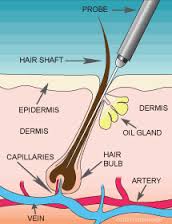Electrolysis and Laser Hair Removal- The difference
25 March 2019
Most of us have hairs in one (or many) areas of the body that we don’t want. It would make life a lot easier if they were gone. Luckily laser hair removal and electrolysis are widely known across the world to reduce or permanently remove hair. Clinics and salons are popping up all over the country claiming their lasers and methods work the best. We thought we could answer some of the most asked questions about hair removal.
How do they actually work? And what is the difference between the two?
Electrolysis
This method has been around since the early 1900’s. Originally a method in the early 1870’s used for the permanent removal of in-grown eyelashes. It is referred to as ‘progressively permanent’ as several treatments are needed. Each follicle needs to be treated individually and a few times each, to achieve a permanent result. The British Advertising Standards Authority has given permission to state that electrolysis is permanent hair removal in advertising. However, because electrolysis isn’t as accessible in all clinics like laser or IPL is, it isn’t often advertised. Such electrolysis clinics are often are in high demand and usually at full capacity.
How electrolysis works
A small single-use needle is inserted into the hair follicle and when prompted emits heat and destroys the follicle, preventing re-growth of a new hair. While laser is effective for hair reduction, it can only treat black or brown hairs while electrolysis can treat any colour.

This is now becoming more apparent to clinics or salons who do not offer this method, that they cannot provide a full range of treatments to meet all of the patient’s needs. Therefore, they are missing out on potential life changing hair removal for their patients. Although electrolysis may be more time consuming than laser, it is permanent. Courses of 4-8 are recommended every 4-6 weeks to begin with. All hair removal methods take time to be fully effective and patience is needed.
How Lasers work
There are lots of different lasers available. The primary principal behind lasers and light-based technologies is selective photothermolysis. This is the ability to target specific chromophores (light-reactive elements) such as melanin, blood or water using specific wavelength or colour of laser or light source.
In laser hair removal the chromophore is melanin, it targets the hair follicle while blood and water are left unharmed. This is why laser cannot treat blonde, white or red hairs as they do not contain melanin. Laser hair removal is fast, anything from 10 minutes to an hour per area depending on the size. It is very effective at removing most hairs in an area to give a permanent reduction.
On average 6-9 treatments are needed. Maintenance is almost always recommended to keep on top of the result and the investment you’ve made. Results are not immediate, and it does require a commitment for a course of 6 or the pay as you go option.
At Skin Medical we are CQC registered https://www.cqc.org.uk/location/1-123558251 we offer both electrolysis and laser hair removal. A consultation involves an assessment of the hair and skin, then we distinguish which method would be best suited for optimum results. With an area of both dark and white hairs, both methods can be recommended.
https://www.skinmedical.co.uk/laser-hair-removal/
How IPL works
Finally we have IPL, which we just wanted to clarify is not as effective for the use of hair removal. IPL has an important part to play in the aesthetics industry for skin as it treats superficial veins and pigmentation, rosacea and acne. It is very effective because of the light source it uses. IPL uses a broad-spectrum visible light where as the laser has a single wavelength of light, making it far more precise to reach the target of melanin.


 Menu Item
Menu Item